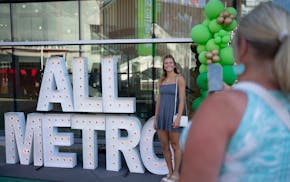The stretch of Interstate 35W between Minneapolis and the south metro suburbs long has been the busiest commuter corridor in the state. Improving bus service along the thoroughfare has been talked about for decades, with little to show for it.
But on Saturday, service began on the Orange Line, a $150 million bus rapid transit (BRT) project that links downtown Minneapolis and Burnsville through Richfield and Bloomington, almost entirely along I-35W.
"The investment we're making here is generational," Gov. Tim Walz said at a chilly ceremony in Minneapolis marking the opening of the route Saturday. "This is not just a bus line; we're connecting communities."
The 17-mile line debuts at a time when infrastructure is front of mind for transit planners and lawmakers alike after President Joe Biden signed a $1 trillion infrastructure bill last month supporting public transportation and other projects nationwide.Future BRT projects planned in the Twin Cities, including the Gold and Purple lines, could benefit from the massive funding package in coming years.
While the $74 million that the Orange Line received from the federal government wasn't part of that infrastructure largesse, Biden touted the project during his trip last week to the Twin Cities.
"It's going to change things," he said.
But its launch comes as the COVID-19 pandemic, and the shift to remote work that followed, have greatly reduced transit ridership — especially commuter routes that traditionally ferried suburban office workers to the downtowns of Minneapolis and St. Paul.
Charles Carlson, Metro Transit's Director of BRT Projects, said the Orange Line's all-day service will fit a new ridership paradigm emerging in the pandemic's wake.
"What we've seen during the pandemic is the strength of all-purpose trips," Carlson said. "While there may have been a reduction in people going into the office during peak morning and peak afternoon hours, we're focusing on all kinds of trips, whether it's shopping, school, medical appointments."
Buses on the Orange Line will run every 15 minutes on weekdays, with 30-minute service on weekends and at nights, seven days a week. One-way trips should take 38 minutes traveling south and 34 minutes heading north.
Buses will use the high-occupancy vehicle (HOV) E-ZPass lanes while on I-35W and the Marquette and 2nd avenue transit corridors in downtown Minneapolis, and they'll have signal priority at most intersections.
The diesel-powered buses have three doors. Passengers must pay before boarding, preventing lines at the farebox. The line's 12 stations, which are heated, feature security cameras and real-time schedule information.
When asked about potential ridership, Carlson noted there were about 14,000 daily bus riders on I-35W before the pandemic.
The line's new $20 million Lake Street station, which opened in October, is a centerpiece of the project. Widely anticipated by transit users, it replaces a decrepit bus stop hemming the freeway and the treacherous steps leading to it from Lake Street.
Metropolitan Council Member Robert Lilligren said he recalls hiking up the stairs years ago and encountering a giant snowbank there. A pair of winter boots was frozen into the icy mound, "as if someone lost them while they jumped on the bus. Now look what we have here."
Construction of the station dovetailed with MnDOT's $240 million Crosstown to Downtown overhaul project along I-35W that was completed this fall. The two-story station is in the center of I-35W and offers elevator service to the boarding platform.
"This is a transformative improvement in access," Carlson said of the Lake Street station. "When the highway was built, there was no access to this neighborhood that was convenient and useful."
Perhaps the biggest feat of engineering on the route is a tunnel under Interstate 494 where it intersects with I-35W along Knox Avenue. It will save 10 minutes in the line's schedule, as buses won't have to cross busy I-494 at grade near Best Buy's headquarters, and it includes lanes for pedestrians and cyclists.
There are no immediate plans to extend the Orange Line, though there's talk about possibly stretching the route to the Burnsville Center mall.
"All of this stuff takes time," Burnsville Mayor Elizabeth Kautz said . "It doesn't happen overnight."

What to know about the latest COVID variants, Minnesota testing, vaccines
Sign up for Star Tribune newsletters

126 birds on list 'lost to science'


